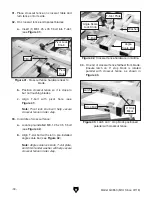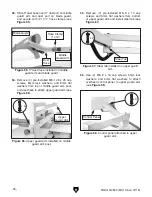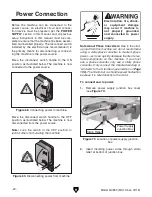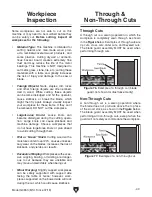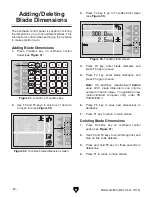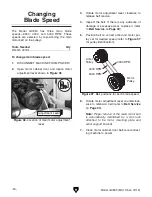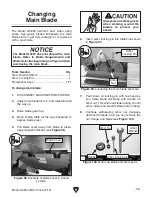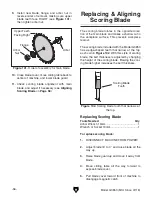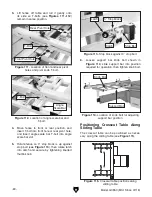
Model G0853 (Mfd. Since 07/18)
-47-
Workpiece
Inspection
Some workpieces are not safe to cut on this
machine or may need to be modified before they
can be safely cut.
Before cutting, inspect all
workpieces for the following:
•
Material Type: This machine is intended for
cutting natural and man-made wood prod-
ucts, laminate-covered wood products, and
some plastics. Cutting drywall or cementi-
tious backer board creates extremely fine
dust and may reduce the life of the motor
bearings. This machine is NOT designed to
cut metal, glass, stone, tile, etc.; cutting these
materials with a table saw greatly increases
the risk of injury and damage to the saw or
blade.
•
Foreign Objects: Nails, staples, dirt, rocks
and other foreign objects are often embed-
ded in wood. While cutting, these objects
can become dislodged and hit the operator,
cause kickback, or break the blade, which
might then fly apart. Always visually inspect
your workpiece for these items. If they can’t
be removed, DO NOT cut the workpiece.
•
Large/Loose Knots: Loose knots can
become dislodged during the cutting opera-
tion. Large knots can cause kickback and
machine damage. Choose workpieces that
do not have large/loose knots or plan ahead
to avoid cutting through them.
•
Wet or “Green” Stock: Cutting wood with a
moisture content over 20% causes unneces-
sary wear on the blades, increases the risk of
kickback, and yields poor results.
•
Excessive Warping: Workpieces with exces-
sive cupping, bowing, or twisting are danger-
ous to cut because they are unstable and
may move unpredictably when being cut.
•
Minor Warping: Slightly cupped workpieces
can be safely supported with cupped side
facing the table or fence; however, work-
pieces supported on the bowed side will rock
during the cut, which could cause kickback.
Through &
Non-Through Cuts
Non-Through Cuts
Figure 77. Example of a non-through cut.
A non-through cut is a sawing operation where
the blade does not protrude above the top face of
the wood stock, as shown in the
Figure below.
Through Cuts
Figure 76. Example of a through cut (blade
guard not shown for illustrative clarity).
A through cut is a sawing operation in which the
workpiece is completely sawn through, as shown
in the
Figure below. Examples of through cuts are
rip cuts, cross cuts, miter cuts, and beveled cuts.
The blade guard assembly MUST be used when
performing through cuts.
A non-through cut is a sawing operation where
the blade does not protrude above the top face
of the wood stock, as shown in the
Figure below.
The blade guard assembly MUST be used when
performing all non-through cuts, except when the
guard will not safely accommodate the workpiece.
Summary of Contents for G0853
Page 24: ...22 Model G0853 Mfd Since 07 18 5mm Hardware Recognition Chart...
Page 140: ......


